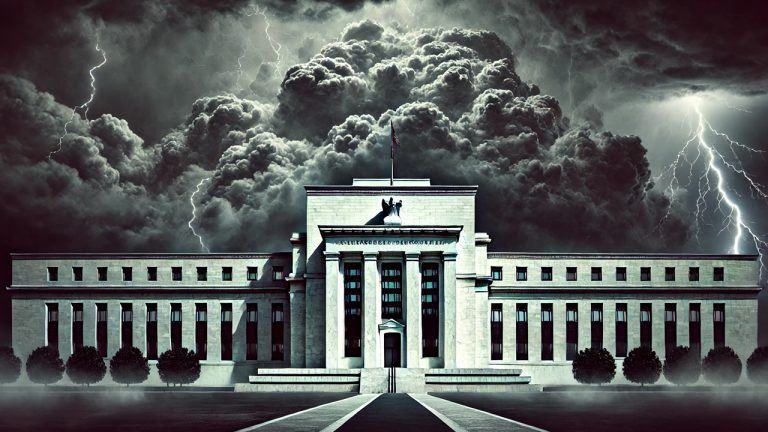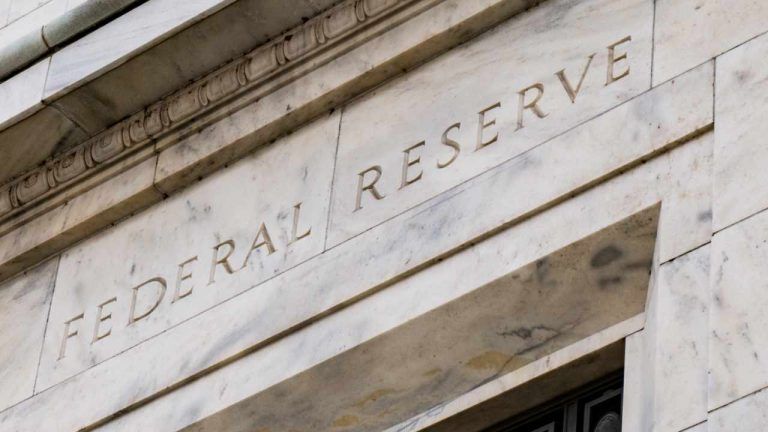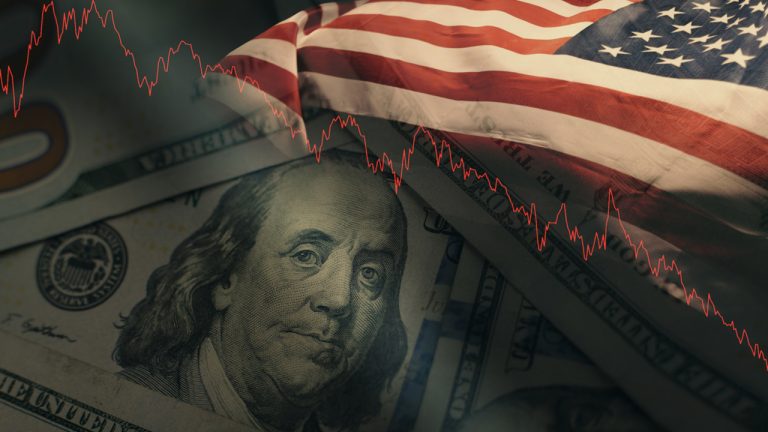The Fed's interest rate decision could significantly influence crypto markets, affecting investor sentiment and economic dynamics globally.
The post Fed holds interest rate steady at 23-year high, possible rate cut coming September appeared first on Crypto Briefing.
 According to the minutes from the Federal Reserve’s Federal Open Market Committee (FOMC), the choice to maintain the federal funds rate in its current range was driven by concerns about ongoing inflation and economic instability. Economic Instability and Inflation Keep Fed Rates Steady At the June 11-12 meeting, the FOMC highlighted that although inflation has […]
According to the minutes from the Federal Reserve’s Federal Open Market Committee (FOMC), the choice to maintain the federal funds rate in its current range was driven by concerns about ongoing inflation and economic instability. Economic Instability and Inflation Keep Fed Rates Steady At the June 11-12 meeting, the FOMC highlighted that although inflation has […] Former Boston Fed President Eric Rosengren has outlined the potential for two interest rate cuts this year. He cited recent Federal Open Market Committee (FOMC) discussions and stabilizing inflation trends. “I am expecting we’ll probably get some more favorable inflation numbers over the next couple of months,” he opined. ‘I Don’t Think We’re Down to […]
Former Boston Fed President Eric Rosengren has outlined the potential for two interest rate cuts this year. He cited recent Federal Open Market Committee (FOMC) discussions and stabilizing inflation trends. “I am expecting we’ll probably get some more favorable inflation numbers over the next couple of months,” he opined. ‘I Don’t Think We’re Down to […] On Wednesday at 11 a.m. EDT, bitcoin hovered just around the $65,000 mark. QCP Capital published its market commentary, attributing the downturn in the crypto economy to a lack of news flow and stagnant markets. In such a market, with minimal positive news to spur buying, existing crypto holders may lose confidence and patience. Crypto […]
On Wednesday at 11 a.m. EDT, bitcoin hovered just around the $65,000 mark. QCP Capital published its market commentary, attributing the downturn in the crypto economy to a lack of news flow and stagnant markets. In such a market, with minimal positive news to spur buying, existing crypto holders may lose confidence and patience. Crypto […]
Digital assets manager CoinShares says crypto products bled out last week to the tune of $600 million. In its latest Digital Asset Fund Flows report, CoinShares says that institutional investors are likely reacting to a more “hawkish-than-expected” Federal Open Market Committee (FOMC) meeting last week. “Digital asset investment products experienced outflows totaling US$600 million, the largest […]
The post $600,000,000 Leaves Crypto ETPs Following More-Hawkish-Than-Expected FOMC Meeting: CoinShares appeared first on The Daily Hodl.

Economist Henrik Zeberg says that the altcoin market is setting up for a parabolic run to new highs before the global economy witnesses a recession. Zeberg tells his 143,000 followers on the social media platform X that he’s looking at the TOTAL-ETH-BTC chart, which measures the entire market cap of crypto assets besides Bitcoin (BTC) […]
The post Economist Henrik Zeberg Says Altcoins Set To Go ‘Flying’ in Blow-Off Top Style Euphoric Bull Run appeared first on The Daily Hodl.
 On Wednesday, May 1, 2024, the U.S. Federal Reserve chose to maintain the benchmark interest rates at their highest in 23 years. The Federal Open Market Committee (FOMC) members noted that although inflation has subsided, it still “remains elevated.” No Change in Federal Funds Rate; Fed Continues Watchful Eye on Inflation Risks On Wednesday, the […]
On Wednesday, May 1, 2024, the U.S. Federal Reserve chose to maintain the benchmark interest rates at their highest in 23 years. The Federal Open Market Committee (FOMC) members noted that although inflation has subsided, it still “remains elevated.” No Change in Federal Funds Rate; Fed Continues Watchful Eye on Inflation Risks On Wednesday, the […]
Bitcoin heads into November to tackle the Fed rate decision day after BTC’s price cements its second-best month of 2023.
Bitcoin (BTC) has seen its highest monthly close since May 2022 after “Uptober” delivered near 30% BTC price gains.

Data from Cointelegraph Markets Pro and TradingView confirms Bitcoin bulls successfully held on to upside into Nov. 1.
After navigating a choppy mid-month trading environment, hodlers were treated to a finale similar in character to October’s initial breakout.
Monitoring resource CoinGlass thus put October as the second best-performing month of 2023. Bitcoin gained 28.5%, trailing only January’s 39.6%.

Reacting, popular trader Bluntz cautioned over discounting what amounts to a “high timeframe weekly range breakout.”
“I believe this current one will be akin to the oct 2020 ones and the april 2019 one,” he wrote in part of an X post around the monthly close.
In both scenarios, BTC/USD entered a new bullish phase, with straight upside lasting several months.

Striking a similar note, fellow social media trading personality Moustache eyed the TK Crossover indicator for a rare bull market trigger.
TK Crossover, which gets its name from a trading signal on the Ichimoku Cloud and involves two of its trendlines, Tenkan-sen and Kijun-sen, produced a once-in-a-cycle bull flag at the monthly close, he said.
#Bitcoin
— ⓗ (@el_crypto_prof) October 31, 2023
The monthly close for October is only a few hours away.
-The last 3 times $BTC has closed above the Conversion Line () in the TK Cross-Indicator, we have seen a bull run in the following months (for at least ~300 days).
Send it higher. pic.twitter.com/pvWrwm0XG7
On a slightly more conservative note, on-chain monitoring resource Material Indicators suggested that bullish momentum, while still present, is waning compared to last month.
“Still waiting for a retest of $33k, although we may not see it until after an attempt at $36k,” it told X subscribers alongside data from one of its proprietary trading tools.
Volatility, meanwhile, remains on the menu for market participants, with the week’s main macroeconomic event due later in the day.
Related: There are now nearly 40M Bitcoin addresses in profit — A new record
This comes in the form of the United States Federal Reserve announcing its interest rate policy amid a testing inflation environment. Fed Chair Jerome Powell will also deliver a speech and hold a press conference.
As Cointelegraph reported, market expectations are for the Federal Open Market Committee (FOMC) to keep rates at current, albeit elevated, levels.
According to the latest data from CME Group’s FedWatch Tool, the odds of that eventuality currently lie at nearly 98%.

Commenting on the potential knock-on effects for BTC price action, popular trader Crypto Tony looked to “more volatility and more movements as the talk begins and data is released.”
“I personally expect a pause and no hikes, so I expect we see a $36,000 hit on this data following a fake out down first,” he added, joining calls for a tap of the $36,000 mark.
This article does not contain investment advice or recommendations. Every investment and trading move involves risk, and readers should conduct their own research when making a decision.

Bitcoin holds higher BTC price levels into what looks to be a crunch week for crypto markets across the board.
Bitcoin (BTC) starts a new week at comfortable highs as traders square off over BTC price action to come.
As macroeconomic uncertainty continues to grow, Bitcoin is cementing its new trading zone above $30,000.
The highest weekly close since early May 2022 is the latest achievement for bulls, and so far, bid support has allowed the market to avoid a deep retracement after last week’s snap 15% gains.
How could the environment change for BTC/USD this week?
As Bitcoin heads into the October monthly close, would-be volatility catalysts are brewing — not least thanks to the increasing geopolitical instability in the Middle East.
Adding to the hurdles for risk assets to overcome is the United States Federal Reserve, which will decide on interest rate adjustments on Nov. 1.
Under the hood, Bitcoin is looking better than ever, and the numbers prove it — network fundamentals are either at or circling all-time highs, continuing a trend in place for much of this year.
As price survives a mass profit-taking event at the hands of speculators, faith in further upside is proving hard to shake — but for some, the specter of a $20,000 crash is still firmly in play.
Cointelegraph takes a look at these factors and more in the weekly rundown of potential BTC price influencers for the coming days.
After its highest weekly close in 18 months, Bitcoin continues to consolidate near $34,000 as the week begins.
A late-weekend surge took BTC price action to $34,700, helping add to the day’s BTC short liquidations, per data from monitoring resource CoinGlass.

Despite this, the last weekly close of October was a calm event compared to a week prior, and with the monthly close now in focus, market participants will be keen to see if “Uptober” retains its bullish status.
Eyeing relative strength index (RSI) behavior, popular analyst Matthew Hyland was optimistic on the day.
“Current Bitcoin position would eliminate any possibility of bearish divergence forming on the weekly later on off the prior RSI high,” he wrote in an X post.
“This is extremely good for the bullish side and worst possible close for the bearish side.”
An accompanying chart showed RSI hitting higher highs on weekly timeframes. In a previous post, Hyland said that a weekly close at current levels would constitute a wider breakout.
#Bitcoin Weekly closes tommorow
— Matthew Hyland (@MatthewHyland_) October 28, 2023
It will potentially confirm a massive breakout of a 6 month+ consolidation
There is also is a chance the weekly RSI will put in a higher high as well and negate any chance at bearish divergence later on pic.twitter.com/WPnkc1e2rE
RSI, which traditionally acts as an overbought signal at a given price when above 70, stood at 69.7 at the time of writing, with BTC/USD at $34,300, per data from Cointelegraph Markets Pro and TradingView.

Similarly buoyant about what could happen to BTC price strength this week was popular trader Titan of Crypto.
In one of his latest X updates, he used the Ichimoku cloud to argue that a breakout toward $40,000 was on the cards.
#Bitcoin at $40,000 next week? #BTC is trying to breakout from both bullish pennant and the inside bar's range.
— Titan of Crypto (@Washigorira) October 29, 2023
Tenkan starts pointing up ↗️.
If the following conditions are matched :
- Kijun followsTenkan.
- Daily candle manages to close above the range and stay… pic.twitter.com/qZ7PZ5L9n2
As Cointelegraph reported last week, $40,000 is a popular target for bulls, but some remain notably surprised by the strength of the recent rally.
Trader Bluntz argued that it was “wild that we broke 32k with conviction held and have now found acceptance above 34k.”
“The doubt and disbelief is still lingering,” he continued in part of X commentary, suggesting that many retained a bear market mentality.
Despite a week of holding higher levels, Bitcoin is far from convincing everyone that they will endure.
As Cointelegraph continues to report, $20,000 is a crash level which is still very much on the radar for some market participants.
The site of both a CME futures gap and the psychologically significant 2017 all-time high, $20,000 has not left traders’ consciousness seven months after BTC/USD last traded there.
All CME gaps filled in the chart,
— Poseidon (@CryptoPoseidonn) October 28, 2023
Except $20k.$BTC pic.twitter.com/YS1XfIotCs
Commenting on the prospect of such a move becoming reality, popular trader and analyst Rekt Capital described it as a “worst case scenario.”
The timeframe for this to occur is the five-and-a-half months remaining until the next block subsidy halving event.
“That would be a -42% drop from here,” he wrote at the weekend.
“How likely is it that this could happen? Worst-case scenarios typically have a low probability of occurring.”
Rekt Capital had previously warned over potential extensive BTC price downside at the hands of a double top pattern for 2023, this subsequently invalidated with last week’s move.
Social media was naturally not short of those disregarding a $20,000 comeback altogether, among them CredibleCrypto, who described the eventuality as “near impossible.”
Bitcoin, he continued on the day, was in line to “melt through” the $40,000 mark.
When I first tweeted this 5 months ago, most disagreed with me.
— CrediBULL Crypto (@CredibleCrypto) October 29, 2023
I think many still do.
When we melt through 40k+, most will finally start to agree with me. $BTC https://t.co/VCChLO6A7Q pic.twitter.com/ulzeiZuTru
Others highlighted necessary levels to hold in order to avoid a rapid unwinding of recent progress.
“Looking for Bitcoin to hold this mid range retest and S/R flip,” analyst Mark Cullen wrote alongside a summary chart.
“If it breaks back below then i think the lower sweep could still be on the cards. Bulls don't really want to see BTC trade for any time back below 32.5k, but a wick below to take liquidity isn't off the table.”

Trader Pentoshi meanwhile said that conditions had not changed on longer timeframes.
$BTC nothing unchanged
— Pentoshi euroPeng (@Pentosh1) October 29, 2023
Most important levels to play marked
Closing below purple = likely deviation and invalidation
40-42k on the table in the weeks ahead pic.twitter.com/MfmKCQZpO3
With trouble increasing in the Middle East and the impacts of war increasingly being felt outside the region, Bitcoin is seeing its second major conflict of the past two years.
Hodlers have a constant potential source of volatility in the background — something which this week will spar with U.S. macro data.
On Nov. 1, the Fed will meet to decide on whether benchmark interest rates should rise — an event which can form a short-term volatility catalyst in its own right.
Bitcoin has nonetheless dismissed Fed rate decisions in recent months, this despite persistent inflation repeatedly beating market expectations.

Per data from CME Group’s FedWatch Tool, markets currently expect the Federal Open Market Committee (FOMC) to leave rates unchanged this week.
“We have a huge week ahead,” financial commentary resource The Kobeissi Letter wrote in part of a summary.
Key Events This Week:
— The Kobeissi Letter (@KobeissiLetter) October 29, 2023
1. Consumer Confidence data - Tuesday
2. JOLTs Job data - Wednesday
3. Fed Rate Decision/Statement - Wednesday
4. Initial Jobless Claims - Thursday
5. October Jobs Report - Friday
6. ~20% of S&P 500 reports earnings this week
We have a huge week…
Kobeissi touched on what could become a fresh BTC price headwind — a correction on the S&P 500. Previously correlated with stocks, Bitcoin’s more recent divergence may be put to the test.
Over the past month, the S&P 500 has lost 4%.

In commentary last week, however, research firm Santiment not only confirmed the waning stocks correlation but also said that this in itself was a sign that the crypto bull market was back.
#Bitcoin scratched its way to a new 17-month high again today. Even better, #crypto market caps are growing as the #SP500 declines. This suggests that $BTC's & #altcoins' 2-year reliance on #equities is gone, a typical recipe for #bullmarket conditions. https://t.co/XXFph87pj6 pic.twitter.com/nVCqyt9t4Z
— Santiment (@santimentfeed) October 25, 2023
For Bitcoin network fundamentals, there is no reason to pause for thought.
At its latest automated readjustment on Oct. 30, difficulty increased by 2.35% — hitting another all-time high.
Now at 62.46 trillion, difficulty reflects that competition among miners is more intense than ever — as Cointelegraph reported, it has never been so complex to mine a single bitcoin.
Hash rate tells an identical story, this circling 493 exahashes per second (EH/s), according to the latest raw data estimates from statistics resource MiningPoolStats.
Commenting on the performance of both difficulty and hash rate, itself near record highs, James van Straten, research and data analyst at crypto insights firm CryptoSlate, described the latter’s progress as a “surge.”
#Bitcoin will record another positive adjustment tomorrow, over 2%.
— James V. Straten (@jimmyvs24) October 29, 2023
In the last few days, we have seen the hash rate knocking on 500 eh/s. Only one day have we seen the hash rate break this record.
This will also be the fourth consecutive positive adjustment, which shows the… pic.twitter.com/H2IZFzNTfm
Jaran Mellerud, a mining analyst at crypto insights firm Arcane Research, predicted that the trend would continue.
“Bitcoin's hashrate will likely continue surging due to the price pump coupled with the fact that miners are trying to outpace each other in upgrading fleets ahead of the halving,” he argued.
“I wouldn't be surprised if we see 500 EH/s before the New Year.”

Waiting in the wings and vying with RSI for upside potential is the classic crypto sentiment gauge, the Crypto Fear & Greed Index.
Related: First Bitcoin ETF trades $1.5B as GBTC ‘discount’ echoes $69K BTC price
Having lingered in a narrow range for months on end, Fear & Greed staged a firm return in line with Bitcoin’s push higher — but unlike BTC price action, it has returned to November 2021 levels.
The latest data shows the Index hitting 72/100 in recent days. This is firmly within the “greed” category and matches its position just days after Bitcoin hit its most recent all-time highs of $69,000 nearly two years ago.
Fear & Greed tends to reach extreme levels before a significant trend change occurs in price action.

This article does not contain investment advice or recommendations. Every investment and trading move involves risk, and readers should conduct their own research when making a decision.

Bitcoin weathers the Fed's decision to keep rates at their previous levels, while Chair Jerome Powell reveals the potential for another hike to come this year.
Bitcoin (BTC) saw snap volatility on Sep. 20 as the United States Federal Reserve maintained interest rates at twenty-year highs.

Data from Cointelegraph Markets Pro and TradingView followed BTC price action as it reacted to the rate decision and accompanying commentary from Fed Chair Jerome Powell.
The Federal Open Market Committee (FOMC) opted to keep rates at their previous levels set in July this year.
“The Committee seeks to achieve maximum employment and inflation at the rate of 2 percent over the longer run,” a press release stated.
“In support of these goals, the Committee decided to maintain the target range for the federal funds rate at 5-1/4 to 5-1/2 percent.”

The move was overwhelmingly expected ahead of time by markets, with a 99% probability of a rate hike pause already in place, per data from CME Group’s FedWatch Tool.
The Fed’s language remained cautious over the future of inflation, however, with no guarantee that conditions would become more lax.
“In assessing the appropriate stance of monetary policy, the Committee will continue to monitor the implications of incoming information for the economic outlook. The Committee would be prepared to adjust the stance of monetary policy as appropriate if risks emerge that could impede the attainment of the Committee's goals,” the release continued.
SUMMARY OF FED DECISION (9/20/23):
— The Kobeissi Letter (@KobeissiLetter) September 20, 2023
1. Fed PAUSES rate hikes leaving rates unchanged
2. 12 Fed officials see 1 more rate hike
3. 7 Fed officials see no more rate hikes
4. Fed sees rates higher for longer
5. Fed sees inflation at 2.6% in 2024
Is the Fed pause finally here?
Reacting, Michaël van de Poppe, founder and CEO of trading firm Eight, suggested that no more rate hikes would come in future. Bitcoin, he predicted, would benefit.
“No rate hike from the FED. My best guess: we're done with the hiking policy,” part of an X post read.
“Bitcoin is likely to start trending up from here (yes, a fakeout usually happens at the news).”
BTC price action saw jitters as the decision came, with Powell still to complete his speech at the subsequent press conference at the time of writing.
Related: Bitcoin price all-time high will precede 2024 halving — New prediction
The road to getting inflation down to the Fed's 2% target, he said, had "a long way to go."
"If the economy evolves as projected, the median participants projects that the appropriate level of the federal funds rate will be 5.6% at the end of this year, 5.1% at the end of 2024 and 3.9% at the end of 2025," he said.
Powell noted that the medium projection for the end of the year was unchanged from before, but had moved up 0.5% for the end of the next two years.
BTC/USD continued to hold above $27,000 as a result, with no major exit of the recent intraday trading range.
This article does not contain investment advice or recommendations. Every investment and trading move involves risk, and readers should conduct their own research when making a decision.